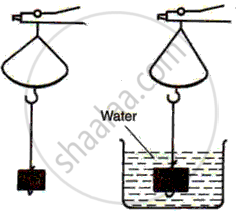Advertisements
Advertisements
प्रश्न
उत्तर
We can find the relative density of a solid denser than water by following the experiment.

Weighing a solid in air and water
Find the weight (W1 gf) of a solid in the air using a hydrostatic balance.
Tie the solid firmly with a thread and suspend it from the hook. Lower the solid in water and find its weight.
Record the result as shown below:
Weight of solid in air = w1 gf.
Weight of solid in water = W2 gf.
The apparent loss of weight of solid = (W1 - W2 ) gf.
Relative density = W1/ (W1 - W2)
The relative density of the solid = (weight of solid in the air )/(Apparent loss of weight of solid in water).
APPEARS IN
संबंधित प्रश्न
State the principle of floatation.
When a piece of wood is suspended from the hook of a spring balance, it reads 70 gf. The wood is now lowered into water. What reading do you expect on the scale of spring balance?
A block of wood is so loaded that it just floats in water at room temperature. What change will occur in the state of floatation, if
(a) Some salt is added to water, (b) Water is heated?
Give reasons.
Why is the floating ice less submerged in brine than in water?
A body of weight W is floating in a liquid. Its apparent weight will be
A body floats in a liquid A of density ρ1 with a part of it submerged inside the liquid, while in liquid B of density ρ2 it is totally submerged inside the liquid. The densities ρ1 and ρ2 are related as :
A rubber ball floats in water with 2/7 of its volume above the surface of the water. Calculate the average relative density of the rubber ball.
Why do petroleum-based products float on the surface of the water?
How do submarines sink and float in water?
Assertion (A): Lactometer is used to check the purity of milk.
Reason (R): Lactometer measures the cream content of milk.
